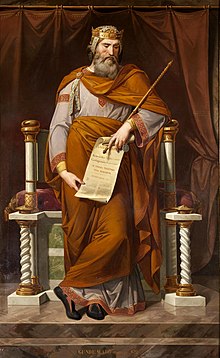You can help expand this article with text translated from the corresponding article in Spanish. (July 2012) Click [show] for important translation instructions.
|
Gundemar was a Visigothic King of Hispania, Septimania and Galicia (610–612).
| Gundemar | |
|---|---|
| King of Hispania, Septimania and Gallaecia | |
 Imaginary portrait of Gundemar, by Bernardino Montañés. Oil on canvas (1858) | |
| King of the Visigoths | |
| Reign | c. April 610 – c. February/March 612 |
| Predecessor | Witteric |
| Successor | Sisebut |
| Died | c. February/March 612 |
| Spouse | Hildoara |
| Religion | Chalcedonian Christianity |

Reign
editGundemar continued a policy of amity with Clotaire II of Neustria and Theodobert II of Austrasia. To this end, he sent grand sums of money to support their cause against their relative (cousin and brother, respectively) Theuderic II of Burgundy. At other times, he pursued a hostile policy against Brunhilda.[1]
According to Isidore of Seville, Gundemar made one expedition against the Basques, then besieged the Byzantines in the following year. With the Byzantine Empire in particular, he had a Casus Belli because of jurisdictional challenge between Carthage and the Spanish church.[2] He died a natural death in Toledo, probably in February or March 612.[3] The Chronica Regum Visigotthorum records that Gundemar reigned for one year, ten months and 14 days.[4] He was succeeded by Sisebut.
He was married to Hildoara.
Legacy
editThe towns of Gondomar in Portugal and in Galicia are named after him.[citation needed]
References
edit- ^ E. A. Thompson, The Goths in Spain (Clarendon P., 1969), p. 160.
- ^ Curtin, D. P. (March 2020). The Decree of 610. Dalcassian Publishing Company. ISBN 9781960069719.
- ^ Isidore of Seville, Historia de regibus Gothorum, Vandalorum et Suevorum, chapter 59. Translation by Guido Donini and Gordon B. Ford, Isidore of Seville's History of the Goths, Vandals, and Suevi, second revised edition (Leiden: E. J. Brill, 1970), p. 27.
- ^ Chronica Regum Visigotthorum, España Sagrada Tomo II [1], p. 173.
External links
edit- (in Spanish) Coins of King Gundemar